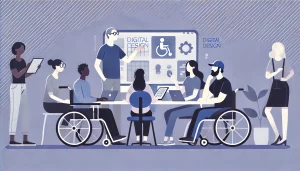
Remember the last time you tried scheduling a doctor’s appointment online? The struggle was real, right? Confusing menus, hidden buttons, and overwhelming medical jargon highlight the dark side of the healthcare system, where patient-centricity often gets lost in outdated technology.
But what if every step of your healthcare journey was as smooth as booking a ride or ordering food online. This is where UX innovation comes in, revolutionising patient-centric healthcare.
The Struggle is Real: Problems with Traditional Healthcare Systems
Traditional healthcare systems have long been designed with a focus on the needs of healthcare providers rather than patients. This has led to several significant problems:
- Complicated Appointment Scheduling: Patients often face long waits on the phone, unclear instructions, and the hassle of coordinating between different departments.
- Ineffective Telehealth Services: Many telehealth platforms are plagued with technical difficulties, making it hard for patients to have a smooth consultation experience.
- Confusing Patient Portals: Accessing medical records and understanding treatment plans can be a challenge due to poorly designed and hard-to-navigate patient portals.
- Lack of Personalized Health Management: Generic health apps often fail to engage users effectively, leading to poor adherence to health and fitness goals.
How UX Innovation Transforms Healthcare
1. Simplified Appointment Scheduling
Modern systems offer user-friendly online booking platforms that allow patients to:
- Schedule appointments at their convenience.
- View available slots in real-time.
- Receive instant confirmations and reminders.
2. Improved Telehealth Services
Telehealth has become a crucial part of healthcare, especially since the COVID-19 pandemic. UX design plays a critical role in enhancing telehealth platforms by ensuring:
- Easy navigation and user-friendly interfaces.
- Clear instructions for joining virtual consultations.
- Reliable video and audio connections.
3. Enhanced Patient Portals
Patient portals are becoming more intuitive. Key features include:
- Simplified navigation to access medical records and test results.
- Visual aids and easy-to-read summaries to help patients understand their health information.
- Secure messaging systems for direct communication with healthcare providers.
4. Personalized Health Apps
Mobile health apps that incorporate good UX design offer personalized experiences. Features such as:
- Customized notifications and reminders.
- Goal setting and progress tracking.
- Interactive and engaging interfaces.
The Impact of UX Innovation
- Increased Patient Engagement : When healthcare systems are easy to use, patients are more likely to engage with them.
- Reduced Administrative Burden: Streamlined processes reduce the workload on healthcare staff.
- Improved Health Outcomes: With improved access and engaging tools, patients can make informed health decisions.
The Road Ahead
The future of healthcare is increasingly patient-centric, with UX innovation at its core. Emerging technologies like Artificial Intelligence (AI) and Machine Learning (ML) are set to further enhance UX in healthcare by providing:
- Personalized health recommendations based on individual data.
- Predictive analytics to foresee potential health issues.
- Voice-activated assistants to help manage health tasks.
- Virtual Reality (VR) for immersive patient education and pain management.
This is a future where navigating the healthcare system won’t be a cause for frustration, but a path to a healthier, happier you.
Also read : User-Centered Emotion: The Key to Effective Design







